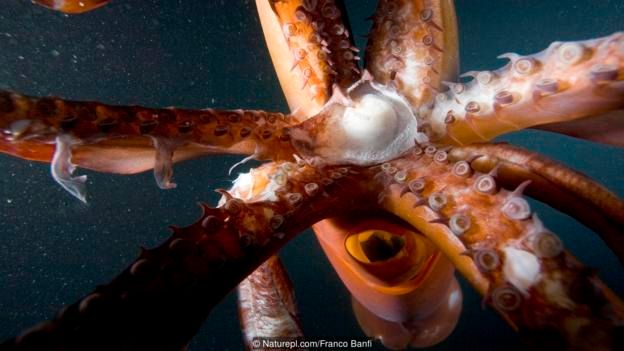Strange animals come to the surface every night

Under the cover of darkness rarely seen creatures migrate to the ocean’s surface to feed.
The Humboldt squid, also known as the jumbo squid, is one of the most eye-catching marine animals you can see lurking in surface waters.
By day the squid lurk in the deep waters of the Eastern Pacific Ocean along the deep shelf that runs off the west coast of the Americas and every night they are one of the many ocean animals to migrate upwards to find dinner.
Vertical (or diel) migration - when ocean animals swim to the surface at dusk and disappear down again at dawn – is extremely common.
“What [Humbioldt squid are] doing largely is following their main food item, which is the so-called lantern fish,” explains Professor Paul Rodhouse, an Emeritus Fellow for the British Antarctic Survey (BAS) and former head of the organisation’s biological sciences division.
In turn, lantern fish follow vertically migrating zooplankton.
Since zooplankton are depended on by so many ocean animals, “the rest of the food chain will be following on after it,” says Prof Rodhouse.
“It is a huge movement of biomass every day,” says Prof Rodhouse. “More than a thousand metres. Some of the oceanic squid probably migrate over 1000m every day.”
He adds that almost all pelagic species (animals that live in the water column not near the bottom or shore) that can swim make the journey.
Humboldt squid are among the most striking creatures to surface every night. Their ability to change colour and flash bright red when agitated has earned them the nickname “red devils”. Although much smaller than their cousin, the 13m-giant squid, they can reach a length of about 1.5m (almost 5ft). Highly aggressive predators, they capture prey with strong tentacles and suckers and tear into it with powerful beaks, and have reportedly occasionally attacked humans.
But even ferocious Humboldts are preyed upon by bigger predators such as billfish, swordfish and sharks.
“Of course what they are all doing [by being active at night] is avoiding predation by the top predators,” says Prof Rodhouse. "The big predators that are visual predators and which stay in the surface waters and see their prey.”
“So they’re all… reducing the risk of being preyed on by going down into deep, dark waters at night.”
For more incredible ocean stories, follow OurBluePlanet on Twitter. Get in touch with to share your most magical ocean moments, and for inspiration watch the launch video on the BBC Earth YouTube Channel.
#OurBluePlanet is a collaboration between BBC Earth and Alucia Productions.